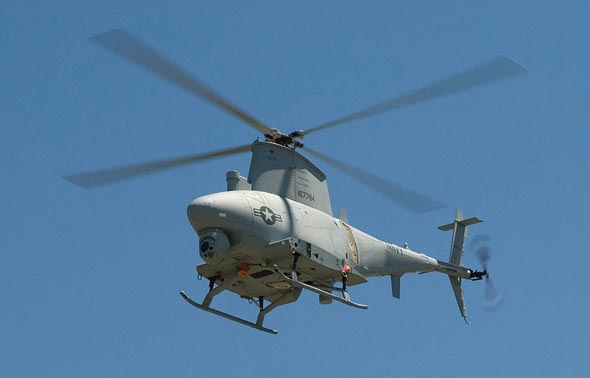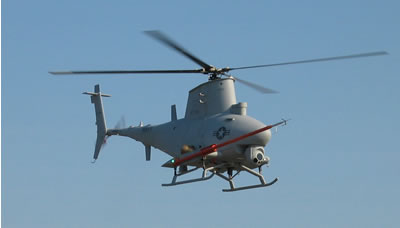An enhanced version of the FireScout Vertical Takeoff UAV (VTUAV) completed an initial series of flight testing conducted by the U.S. Navy and Northrop Grumman.
The new model offers a significant capability increase over the first generation RQ-8A Fire Scout. It has a four blade rotor, and other enhancements giving the aircraft longer endurance (over eight hours) greater payload carrying capacity of up to 600 pounds (272 kg).
With vehicle endurance greater than six hours, Fire Scout will be capable of continuous operations providing coverage 110 nautical miles from the launch site. A baseline payload that includes electro-optical/infrared sensors and a laser designator enables Fire Scout to find tactical targets, track and designate targets, accurately provide targeting data to strike platforms and perform battle damage assessment. FireScout was also selected for the US Army FCS Class IV UAV, offering future units of action a flexible, weaponized ISR and attack platform.
With additional fuel capacity, the MQ-8B can stay on station for six hours at 110 miles (176 km) from launch site. The Navy plans to use Fire Scout on board the Littoral Combat Ship, where sailors will operate both manned and unmanned helicopters to support operational requirements.
FireScout conducted a series of flight tests that culminated in two successful launches of a 2.75-inch Hydra-class rocket from the Fire Scout Vertical Takeoff Unmanned Aerial Vehicle (VTUAV). Fire Scout is programmed to become operational in fiscal year ’09 and deploy aboard the littoral combat ship. The Fire Scout was re-designated MQ-8B, which reflects the aerial vehicle’s multi-mission functionality. The Navy is acquiring the MQ-8B Fire Scout UAV to fulfill the service’s requirement for a tactical UAV capable of operating in the shipboard environment.
On May 30, 2007 The U.S. Department of Defense awarded Northrop Grumman Corporation’s (NYSE:NOC) $13.6 million for the procurement of long lead items, in support of the low-rate initial production of MQ-8B Fire Scout Vertical Takeoff and Landing Tactical Unmanned Aerial Vehicle (VTUAV). “The Fire Scout program is on track to conduct payload flights this fall and enter initial operational evaluation and then achieve initial operational capability in 2008 as planned,” said CDR Rob Murphy, Navy VTUAV program manager. The Fire Scout’s operational requirements include real-time video imagery collection, intelligence gathering, communications-relay capability, precision targeting and battle damage assessment from the Littoral Combat Ship. The Navy has nine Fire Scouts currently on contract with Northrop Grumman. The first was delivered in November to Naval Air Station Patuxent River. The successful series of first flights was completed just weeks later. All nine are expected to be delivered by the end of 2008.
FireScout Industry Team
System design work on the Fire Scout is performed at the Integrated Systems Unmanned Systems Development Center in San Diego, Calif. The Fire Scout is assembled at the Unmanned Systems Center in Moss Point, Miss. The VTUAV is based on a commercial-off-the-shelf Schweizer 333 manned helicopter manufactured in Horseheads, N.Y. The baseline design has proven a highly reliable and effective platform with extensive operating history.
With Northrop Grumman as prime contractor, the MQ-8B Fire Scout industry team also includes Schweizer Aircraft Corporation, the platform’s designer and airframe manufacturer and Rolls-Royce Corporation, delivering the engine.
Avionics providers include Rockwell Collins supplying avionics, GE Fanuc produces produced the vehicle management computer, Kearfott Inc. supplies the guidance and navigation systems and Cubic Defense Applications delivering the communications systems. The BriteStar II EO payload is supplied by FLIR Systems.
Ship integration is performed by Lockheed Martin Corporation, which integrated the unmanned common automatic recovery system from Sierra Nevada Corporation. Raytheon Company supplied the tactical control system.
MQ-8B Complete First LRIP Deliveries for the U.S. Navy
By November 2009 Northrop Grumman delivered the first three production MQ-8B Fire Scout Vertical Takeoff and Landing Tactical Unmanned Air Vehicle (VTUAV) produced for the U.S. Navy. The delivery completes the program’s first year of Low Rate Initial Production (LRIP) program. Two of the three vehicles were deployed aboard the USS McInerney for use on a scheduled operational deployment to complete a Fire Scout Military Utility Assessment (MUA). Prior to the current deployment, Fire Scouts have been aboard the USS McInerney four times since December 2008, completing 110 ship takeoffs and landings and 45 landings with the harpoon grid, accumulating over 47 hours of flight time.


















